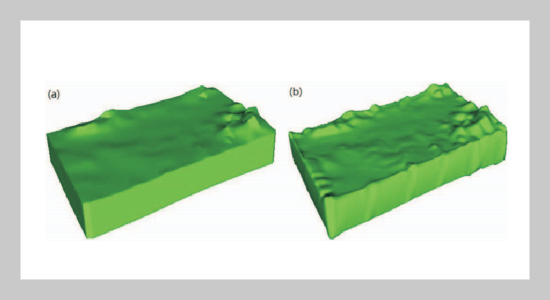REFERENCES
- [1] Ming, J., Pan, M., Qu, H. G. and Ge, Z. H., “GSIS: A 3D Geological Multi-body Modeling System from Netty Cross-sections with Topology,” Computers & Geosciences, Vol. 36, No. 6, pp. 756767 (2010). doi: 10. 1016/j.cageo.2009.11.003
- [2] Vanneschi, C., Salvini, R., Massa, G., Riccucci, S. and Borsani, A., “Geological 3D Modeling for Excavation Activity in an Underground Marble Quarry in the Apuan Alps (Italy),” Computers & Geosciences, Vol. 69, pp. 4154 (2014). doi: 10.1016/j.cageo.2014.04. 009
- [3] Gong, J. Y., Cheng, P. G. and Wang, Y. D., “Three-dimensional Modeling and Application in Geological Exploration Engineering,” Computers & Geosciences, Vol. 30, No. 4, pp. 391404 (2004). doi: 10.1016/S00 98-3004(04)00018-4
- [4] Collon, P., Steckiewicz-Laurent, W., Pellerin, J., Laurent, G., Caumon, G., Reichart, G. and Vaute, L., “3D Geomodelling Combining Implicit Surfaces and Voronoi-based Remeshing: A Case Study in the Lorraine Coal Basin (France),” Computers & Geosciences, Vol. 77, pp. 2943 (2015). doi: 10.1016/j.cageo.2015.01. 009
- [5] Wu, Q., Xu, H. and Zou, X. K., “An Effective Method for 3D Geological Modeling with Multi-source Data Integration,” Computers & Geosciences, Vol. 31, No. 1, pp. 3543 (2005). doi: 10.1016/j.cageo.2004.09. 005
- [6] Emery, X., “Simulation of Geological Domains Using the Plurigaussian Model: New Developments and Computer Programs,” Computers & Geosciences, Vol. 33, pp. 11891201 (2007). doi: 10.1016/j.cageo.2007.01. 006
- [7] Kaufmann, O. and Martin, T., “3D Geological Modelling from Boreholes, Cross-sections and Geological Maps, Application over Former Natural Gas Storages in Coal Mines,” Computers & Geosciences, Vol. 34, No. 3, pp. 278290 (2008). doi: 10.1016/S0098-3004(08)00 227-6
- [8] Gallerini, G. and De, D. M., “3D Modeling Using Geognostic Data: The Case of the Low Valley of Foglia River (Italy),” Computers & Geosciences, Vol. 35, pp. 146164 (2009). doi: 10.1016/j.cageo.2007.09.012
- [9] Wu, Q. and Xu, H., “An Approach to Computer Modeling and Visualization of Geological Faults in 3D,” Computers & Geosciences, Vol. 29, pp. 503509 (2003). doi: 10.1016/S0098-3004(03)00018-9
- [10] Breunig, M., “An Approach to the Integration of Spatial Data and Systems for a 3D Geo-information System,” Computers & Geosciences, Vol. 25, No. 1, pp. 3948 (1999). doi: 10.1016/S0098-3004(98)00104-6
- [11] Shi, W. Z., Wu, L. X., Li, Q. Q., Wang, Y. B. and Yang, B. S., “Models and Algorithms for Three-Dimensional Spatial Information System,” Electronic Industry Press, Beijing, p. 108 (2007).
- [12] Zhong, D. H., Li, M. C., Song, L. G. and Wang, G., “Enhanced NURBS Modeling and Visualization for Large 3D Geoengineering Applications: An Example from the Jinping First-level Hydropower Engineering Project, China,” Computers & Geosciences, Vol. 32, No. 9, pp. 12701282 (2006). doi: 10.1016/j.cageo. 2005.11.007
- [13] Longoni, M., Malossi, A. C. I., Quarteroni, A., Villa, A. and Ruffo, P., “An ALE-based Numerical Technique for Modeling Sedimentary Basin Evolution Featuring Layer Deformations and Faults,” Journal of Computational Physics, Vol. 230, pp. 32303248 (2011). doi: 10.1016/j.jcp.2011.01.027
- [14] Wu, L. X., Shi, W. Z. and Gold, C., “Spatial Modeling Technologies for 3D GIS and 3D GMS,” Geography and Geo-Information Science, Vol. 19, No. 1, pp. 511 (2003).
- [15] Guglielmetti, L., Comina, C., Abdelfettah, Y., Schill, E. and Mandrone, G., “Integration of 3D Geological Modeling and Gravity Surveys for Geothermal Prospection in an Alpine Region,” Tectonophysics, Vol. 608, pp. 10251036 (2013). doi: 10.1016/j.tecto.2013.07. 012
- [16] Jørgensen, F., Møller, R., Nebel, L., Jensen, N. P., Christiansen, A. V., Peter, B. E. and Sandersen, P. B. E., “AMethod for Cognitive 3D Geological Voxel Modelling of AEM Data,” Bulletin of Engineering Geology and the Environment, Vol. 72, No. 34, pp. 421 432 (2013). doi: 10.1007/s10064-013-0487-2
- [17] Lindsay, M. D., Jessell, M. W., Ailleres, L., Perrouty, S., de Kemp, E. and Betts, P. G., “Geodiversity: Exploration of 3D Geological Model Space,” Tectonophysics, Vol. 594, pp. 2737 (2013). doi: 10.1016/j.tecto. 2013.03.013
- [18] Xing, H. L. and Liu, Y., “Mesh Generation for 3D Geological Reservoirs with Arbitrary Stratigraphic Surface Constraints,” Procedia Computer Science, Vol. 29, pp. 897909 (2014). doi: 10.1016/j.procs.2014.05.081
- [19] Xu, T., Li, F., Wu, Z. B., Wu, C. L., Gao, E. G., Zhou, B., Zhang, Z. J. and Xu, G. M., “A Successive Threepoint Perturbation Method for Fast Ray Tracing in Complex 2D and 3D Geological Models,” Tectonophysics, Vol. 627, pp. 7281 (2014). doi: 10.1016/j. tecto.2014.02.012
- [20] Zhu, L. F., Li, M. J., Li, C. L., Shang, J. G., Chen, G. L., Zhang, B. and Wang, X. F., “Coupled Modeling between Geological Structure Fields and Property Parameter Fields in 3D Engineering Geological Space,” Engineering Geology, Vol. 167, pp. 105116 (2013). doi: 10.1016/j.enggeo.2013.10.016
- [21] Houlding, S. W., “3D Geoscience Modeling: Computer Techniques for Geological Characterization,” Springer-Verlag, Berlin, p. 309 (1994). doi: 10.1007/978-3- 642-79012-6_2
- [22] Wu, L. X., “Topological Relations Embodied in a Generalized Tri-prism (GTP) Model for a 3D Geoscience Modeling System,” Computers & Geosciences, Vol. 30, No. 4, pp. 405418 (2004). doi: 10.1016/S00 98-3004 (04)00019-6
- [23] Qu, H. G., Pan, M., Dong, P., Cai, H. and Ming, J., “Smoothing Method of 3D Geological Models Based on Mesh Subdivision,” Geography and Geo-Informa tion Science, Vol. 23, No. 6, pp. 1417 (2007).
- [24] Wang, Y. Z., Sheng, Y. H., Liu, X. S. and Chen, J., “Research on the Method of Geological Three-dimensional Modeling Based on Subdivision Virtual Drills,” Journal of Information and Computational Science, Vol. 11, No. 18, pp. 67136724 (2014). doi: 10.12733/jics2010 5086
- [25] Wang, Y. Z., “Research on the Unified Data Model of Three-dimensional Representation and Analysis Calculation of Underground Spatial Objects Based on the Complex Chain,” Ph.D. Thesis, Nanjin Normal University, Nanjin, pp. 6876 (2012).
















